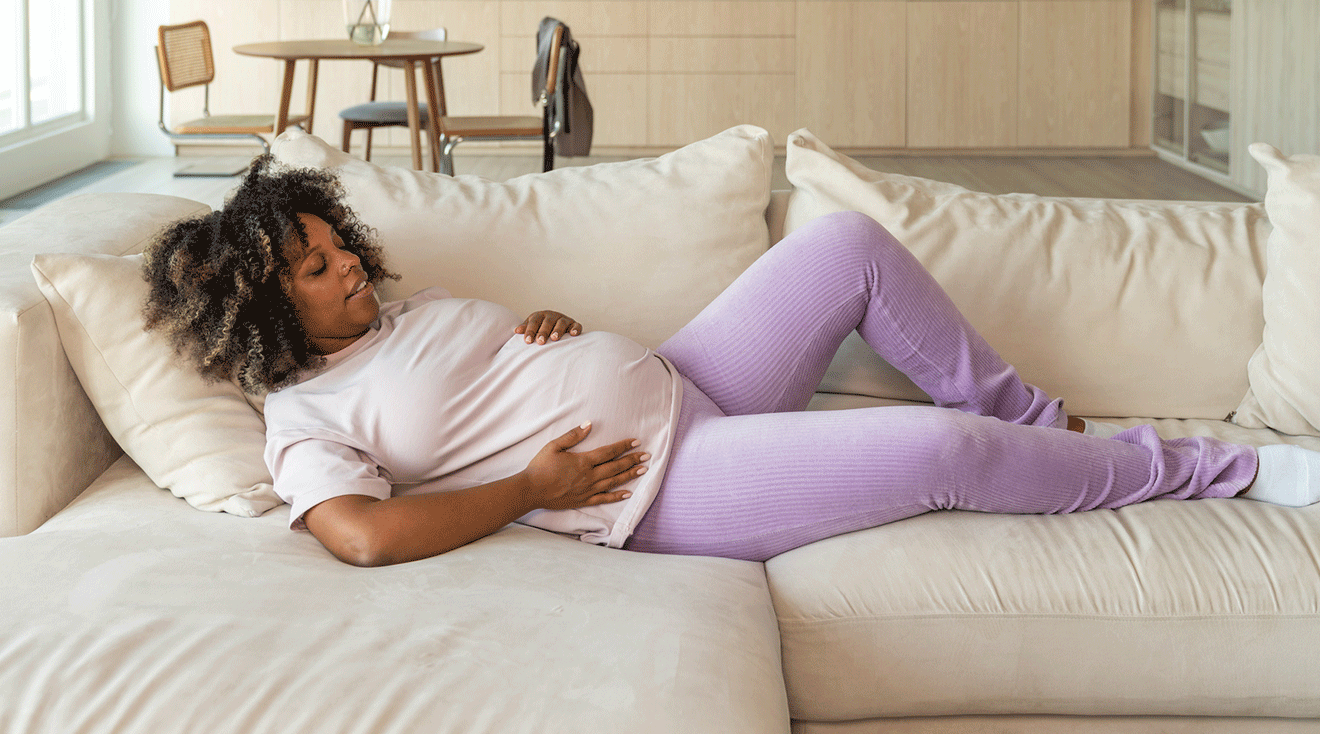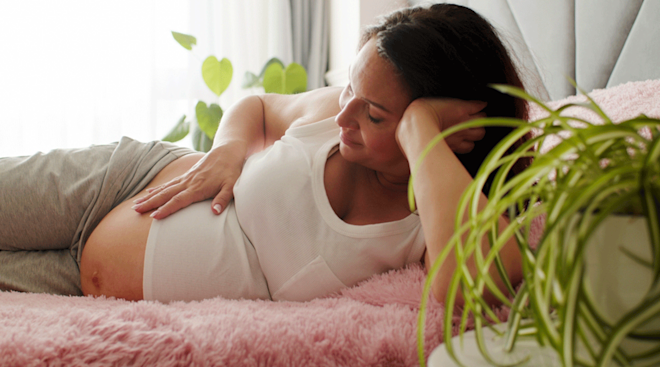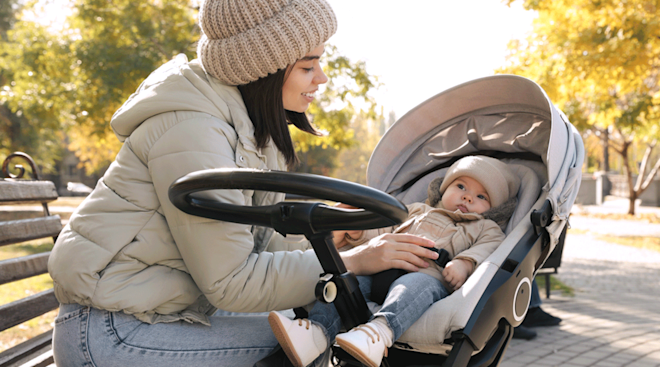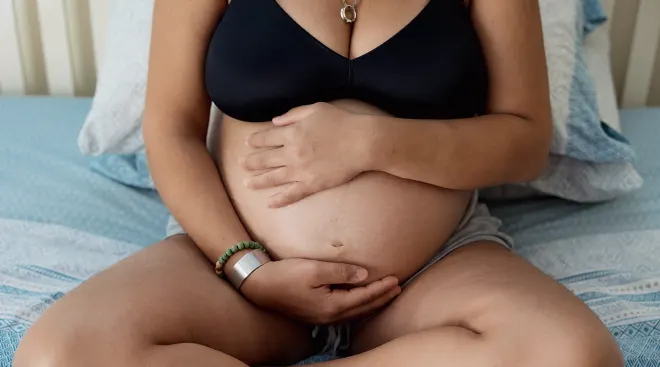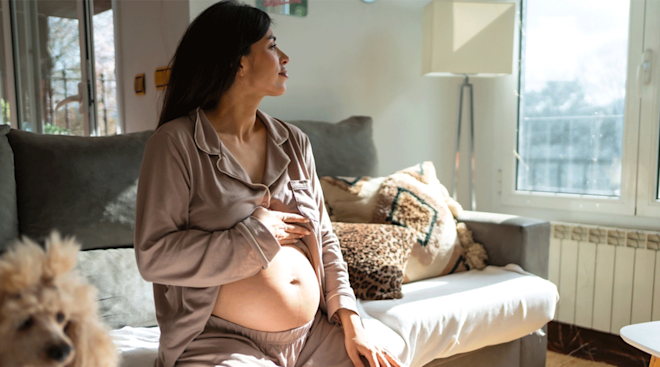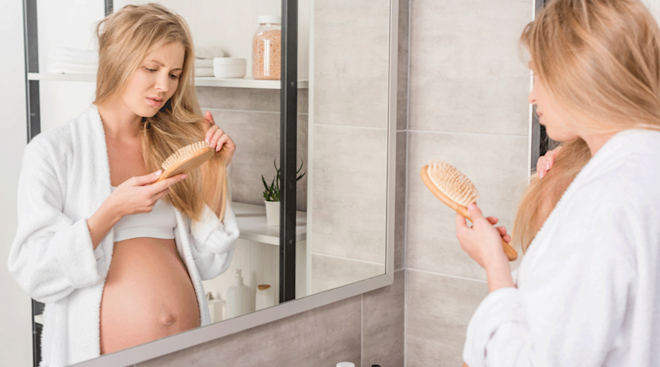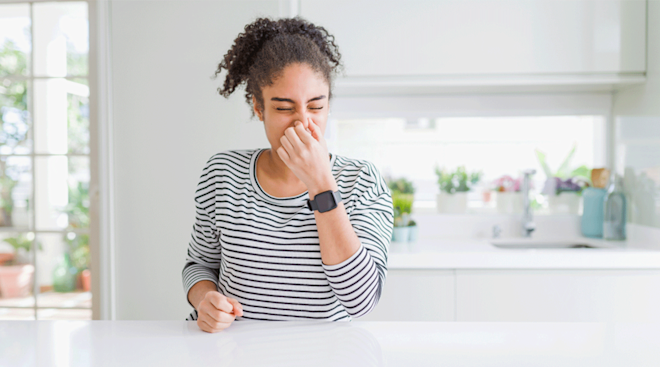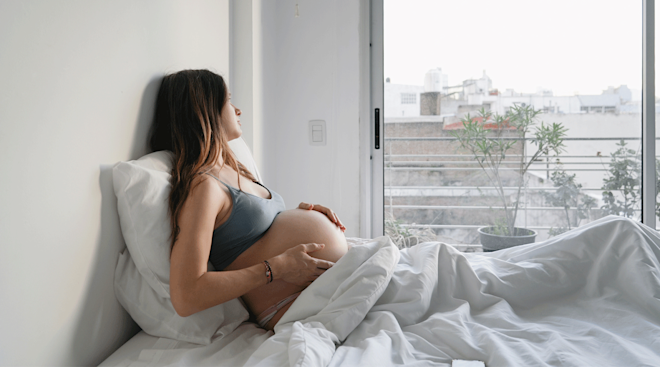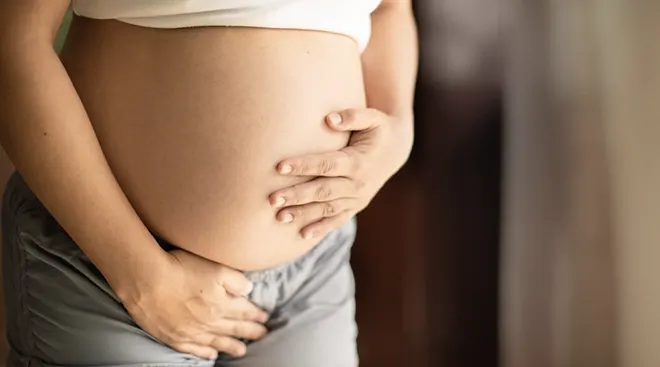Why You Might Experience Joint Pain During Pregnancy
Aches and pains are par for the course during pregnancy, thanks to all the hormonal and physical changes your body goes through. Among the list of pesky symptoms you’ll likely deal with during those nine+ months is joint pain during pregnancy. Unfortunately, most women experience some degree of joint pain while pregnant, particularly as they near their third trimester. In fact, it’s so common there are even myths around how aching knees can predict baby’s sex (spoiler alert: there’s no science behind anecdotes). So why exactly does joint pain in pregnancy happen, when does it start and what can you do about it? Read on as experts break down what you need to know.
Joint pain in pregnancy is exactly what it sounds like: You might feel stiffness, soreness or pain in the places your body bends—and there are several reasons for this, most of which stem from hormonal changes in pregnancy. It’s important to note, however, that joint pain in pregnancy can be different from pregnancy arthritis. “Arthritis is the result of inflammation in the joint,” explains Lisa Jackson, MD, FACOG, an ob-gyn and partner at Uptown OBGYN of New York. “Joint pain in pregnancy is usually caused by increased weight on the joints, the change in the center of gravity as the uterus grows and the relaxation of the ligaments that occur in pregnancy.”
Below, more on why your joints are hurting during pregnancy:
- Pregnancy weight gain: Pregnancy weight gain is important for a healthy pregnancy, but it can put strain on your joints and cause pain, especially if it’s your first baby, explains Joseph A. Salinas, MD, ob-gyn at Kelsey-Seybold Clinic in Houston.
- Fluid retention: Fluid retention and swelling is another normal part of pregnancy. But this, in addition to the weight gain, can cause increased pressure in the joints, particularly at the wrist, says Salinas.
- Enlarged uterus: As pregnancy progresses, your uterus will get bigger, which can shift your center of gravity and affect your posture, Jackson says. All of this puts increased pressure on your joints and can cause pain.
- Relaxin: This is a pregnancy hormone that promotes laxity in the ligaments and joints, which can “stretch them out” and also contribute to joint problems in pregnancy, explains Caitlyn Tivy, PT, DPT, OCS, a physical therapist and medical advisor at Aeroflow Breastpumps. If you exercise a lot, you might also get joint pain from overuse, Salinas adds.
- Hypothyroidism: Joint pain can be a symptom of hypothyroidism, but Salinas points out that pregnant women and people are normally screened for the condition at the beginning of pregnancy, so if you had it, you’d probably know it already. When caught early, hypothyroidism usually doesn’t cause any complications. “A lot of women with hypothyroidism deliver healthy babies every day,” he confirms. “We just have to be sure that their levels are checked and that they’re on supplementation throughout the pregnancy.”
Unfortunately, joint pain can last throughout pregnancy, starting in the first trimester, due to hormonal changes (i.e. relaxin) that affect the ligaments, Jackson says. However, it’s usually most commonly experienced closer to the third trimester since when “a pregnant person is at their heaviest, the uterus is large and retention of fluid is the worst.”
“Joint pain can occur in many body parts during pregnancy, including the pelvic girdle (front and back), lower back, mid-back and upper back,” Tivy notes, but there are four joints in particular where you might feel pain while pregnant. Read on to learn more about each:
Sacroiliac joint pain in pregnancy
The sacroiliac (SI) joint is located in your pelvis and helps with weight distribution between the upper and lower body. “As the pelvis expands to accommodate the growing baby, it undergoes structural changes that can strain the SI joint,” Tivy says. In other words, your expanding uterus, prenatal weight gain, postural changes, relaxed ligaments and weakened core muscles all contribute to increased stress and instability in the SI joint, leading to pain in the pelvis, tailbone and lower back. You’ll likely also experience discomfort when standing or sitting for long periods of time, Jackson adds.
Knee pain in pregnancy
If you’re pregnant and your knees hurt, you’re not alone. Pregnancy can alter your posture and gait, especially as the body struggles to carry baby’s added weight, experts note. This, in turn, can lead to knee pain while pregnant, particularly for individuals with a smaller bone structure, Tivy adds.
Sore hand joints during pregnancy
Fluid retention in the body causes swelling, which can lead to sore wrists and hands, Jackson says. In fact, carpal tunnel syndrome is a common pregnancy complaint and usually occurs due to relaxin, which leads to loose ligaments and increased inflammation in the wrist. You might also experience “mommy thumb” (medically known as De Quervain’s tenosynovitis) if you have older children, Tivy adds. This occurs when the tendon on the outside of the thumb and wrist becomes inflamed due to repetitive hand motions (i.e. lifting up small kiddos).
Elbow pain in pregnancy
Elbow pain in pregnancy is less common—but that doesn’t mean it doesn’t happen, Tivy says. “It’s less aggravating than other areas of pain, so this may cause some folks to prioritize other painful joints and regions over elbow pain.”
If you’re suffering from joint pain while pregnant, rest assured there are ways to find relief. Some tips include:
- Staying active: “Avoid being sedentary because this can actually make pain worse,” Tivy says, “Exercise provides a regular dose of natural pain-killing chemicals.” According to the American Pregnancy Association (APA), regular physical activity during pregnancy can help keep joints flexible. Low-impact activities such as swimming and walking can be especially beneficial. Stretching can also help the body “adjust better to the new body mechanics required with this new shift in the center of gravity,” Jackson adds. She also recommends strength training to build up and stabilize the muscles around the joints.
- Going for a prenatal massage and acupuncture: Per the APA, massage therapy and acupuncture can be effective in treating pain, tension and stiffness around joints.
- Trying hot and cold therapy: The APA lists a warm shower or bath, heating pads and ice packs as effective ways to relieve swelling and joint pain. “If your feet and ankles are swollen and sore, a cold soak and a foot massage is helpful. (The same goes for swollen hands),” Jackson adds. (While warm baths are okay, hot tubs should be avoided during pregnancy.)
- Eating a nutritious diet: A nutrient-dense diet with vegetables “will have all of the vitamins and minerals that you need for healthy bones and muscles,” Jackson says, which can lay a strong foundation for all the physical changes pregnancy brings. The APA also recommends eating foods rich in omega-3 fatty acids or supplements to relieve joint stiffness. (Avoid gamma-linolenic fatty acids and turmeric, as these foods aren’t safe for pregnancy, the organization notes.)
- Wearing supportive footwear: Considering pregnancy can change your gait and posture, it’s especially important to have supportive shoes. The APA recommends avoiding high heels and anything else that puts added strain on your knees and ankles.
- Resting: With all your to-dos, this can seem challenging, but one of the best ways to find relief from pregnancy joint pain is to rest and put your feet up—literally. In severe cases, your provider may also recommend splints for the hands and knees to provide support.
In certain cases, Salinas says Tylenol can also help relieve joint pain during pregnancy, but it shouldn’t be relied upon or used consistently.
The common consensus is that staying active is the best way to get relief from joint problems in pregnancy. Below, Tivy and Jackson offer a breakdown of the best exercises to try by trimester:
- All trimesters: Tivy touts diaphragmatic breathing with deep abdominal engagement as an easy but crucial breathing technique to help activate the proper muscles during core exercises. It also helps prevent you from holding your breath during the exercise. Additionally, she recommends exercises like rows and pull-downs to strengthen the upper back, as well as kegels to keep the pelvic floor strong and pelvis stabilized.
- First trimester: Core exercises are great to improve abdominal strength before your uterus really starts to expand. It’s okay to do these on your back during the first trimester, as long as they’re done for short periods of time and you change positions if you start feeling dizzy or lightheaded, Tivy says. Bridges are also great for your spine and knees.
- Second and third trimester: During the second and third trimesters, you’ll want to avoid laying on your back for too long. Instead try exercises like clamshells, side-lying leg lifts and side steps, Tivy says. These are all also great for building hip strength, which will come in handy when dealing with postural changes. She also recommends isometric exercises, which involve holding a muscular contraction without much movement, like wall sits.
While there are plenty of ways to treat joint pain while pregnant, there are also some methods you’ll want to avoid, including:
- Overstretching: This is more likely to occur during pregnancy, due to relaxin, and your risk may increase with certain forms of yoga. Instead, Tivy suggests working with prenatal yoga instructors who specialize in gentle poses suitable for pregnant women.
- Unapproved supplements: You should always check in with your provider before taking any supplements for joint pain (i.e. glucosamine and chondroitin), as some of these may not be suitable for pregnancy.
- Unapproved braces: Light compression garments can help, but avoid using bulkier braces (i.e. an SI belt) unless approved and fitted by a medical professional. “These can actually worsen symptoms if used improperly,” Tivy says.
- Ibuprofen: For pain relief, avoid using ibuprofen and other NSAIDs during pregnancy, as these can increase the risk of adverse fetal effects.
It’s hard to discern if joint pain during pregnancy is preventable. That said, staying active and maintaining muscle strength can help reduce your risk, as people who are sedentary have a higher risk of developing joint and other types of pain in pregnancy, Tivy says. “Your body is changing a lot, so it needs a lot of extra TLC to keep the muscles functioning as they ought to stabilize your joints during pregnancy,” she adds.
Ultimately, this will vary from person to person. “Remember, 6 weeks postpartum doesn’t really mean much—the first 12 weeks postpartum (‘fourth trimester’) are when the biggest changes happen. But many people find it takes a year or more to feel ‘mostly normal’ again,” Tivy says. According to the experts, while there’s no official end date for the pain, slowly working out after birth (once cleared by your provider) and staying active can help you regain strength and expedite recovery.
This will depend on how severe and sudden your pain is and whether you’ve experienced an injury. For mild joint pain, it’s fine to wait and mention it at your next office visit, says Salinas. However, if your pain worsens or doesn’t improve, don’t hesitate to call the office.
Tivy notes some other red flag warning signs that could indicate inflammation or an infection in the join, including:
- Swelling
- Redness
- Warm to touch
- Fever
Also, see your doctor if you’ve been around someone with parvovirus (aka fifth disease), which can also cause joint pain. “There are some birth defects associated with parvovirus, especially if you’re in the first trimester, but it’s rare,” says Salinas. That’s because most adults have been exposed to it as kids and are now immune. But if you’re exposed to someone (usually a small child) with fifth disease, he suggests you see your doctor to get your blood counts and antibody levels checked.
“Advocacy for your own health is essential, particularly if current treatments or advice are ineffective,” Tivy says. “Don’t be afraid to push for treatment options and/or referrals if your doctor isn’t offering them, especially if you’ve mentioned the pain more than once.”
Please note: The Bump and the materials and information it contains are not intended to, and do not constitute, medical or other health advice or diagnosis and should not be used as such. You should always consult with a qualified physician or health professional about your specific circumstances.
Plus, more from The Bump:
Lisa Jackson, MD, FACOG, is an ob-gyn with over 15 years of experience and a partner at Uptown OBGYN of New York. She earned her medical degree from Vanderbilt University School of Medicine in Nashville, Tennessee and completed her residency in Chicago at Rush University Medical Center. She also serves as an assistant clinical professor of ob-gyn at the Mount Sinai Hospital in New York City.
Joseph A. Salinas, MD, is an ob-gyn at Kelsey-Seybold Clinic in Houston with over 30 years of experience. He earned his medical degree and completed his residency at Baylor College of Medicine.
Caitlyn Tivy, PT, DPT, OCS, is a physical therapist specializing in pelvic health and medical advisor at Aeroflow Breastpumps. She earned her degree at the University of Colorado's Anschutz Medical Campus and completed her residency in orthopedic manual physical therapy with Evidence in Motion in Austin, Texas.
American Pregnancy Association, Treating Joint Pain Naturally During Pregnancy
Learn how we ensure the accuracy of our content through our editorial and medical review process.
Navigate forward to interact with the calendar and select a date. Press the question mark key to get the keyboard shortcuts for changing dates.

































